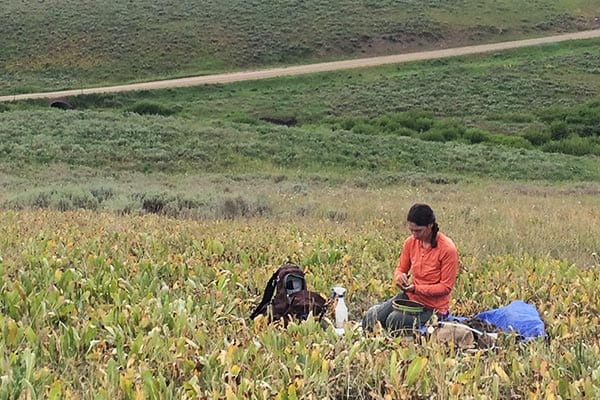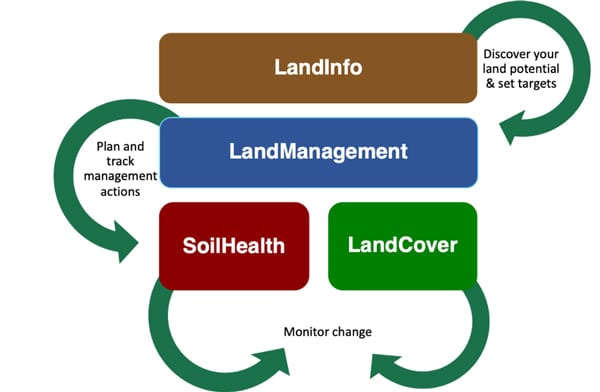LandPKS Learning
Knowledge Hub

What is Land Potential?
It is important to understand not only the potential production capacity of land but also its potential resilience. Land potential is the capacity of land to resist and recover from degradation.
LandPKS stands for the Land Potential Knowledge System. It is important to understand not only the potential production capacity of land but also its potential resilience. Land potential is the capacity of land to resist and recover from degradation. This potential is determined by the climate, soils, and topography of the land. Viewing land management through the lens of land potential can support sustainable agricultural production, biodiversity conservation, and other ecosystem services by matching land use with the capacity of the land to meet our current and future needs.

Land potential is defined as the inherent potential of the land to sustainably generate ecosystem services required to meet today’s needs without compromising our ability to meet the needs of the future. A mismatch between land use and land potential can result in catastrophic land degradation as well as unrealized production opportunities.
Land potential includes three elements:
- inherent potential for generation of ecosystem services based on soil, topography and climate of the area
- resistance to potential degradation, and
- potential resilience, or in other words, the ability of the land to recover following degradation.
Short-term vs. Long-term Land Potential
Land potential can also be broken down into long-term and short-term potential.
- Long-term land potential is based on relatively static or inherent properties of the land including slope, landscape position, soil depth, soil texture and mineralogy, and climate.
- Short-term land potential is the potential of the land at a particular moment in time. Short-term land potential depends on soil properties that change over time, or are more dynamic, such as organic matter content, structure and nutrient availability.
Some properties are dynamic, but the potential range of variability is strongly limited by static properties. For example, the ability to manage a soil to a neutral pH depends on the soil’s inherent mineralogy. Weather, such as drought, also affects short-term potential. In summary, whether the potential of the land is sustainably realized depends on how the land is managed.
How LandPKS Helps Understand Long-Term Land Potential

Through the LandPKS mobile app, you can discover the long-term potential of the land by determining your soil texture, identifying your soil (link to SoilID page on website), and describing your slope in the LandInfo module. You can also access climate information directly from the app.
Combined with additional information on your soil limitations, LandPKS uses your soil data to predict the Land Capability Class, a ranking system that can help identify potential degradation risks to your land. (link to LCC page on website).
How LandPKS Helps Understand and Monitor Changes in Short-Term Land Potential
You can also document and monitor changes in short-term land potential with the SoilHealth and LandCover modules. In the SoilHealth module, you can monitor key field observation indicators right from the app without any lab tests. If you are doing soil lab tests, you can also enter those soil health indicators into the app for easy storage and access. In pastures and rangelands, the LandCover module is used to inventory and monitor vegetation cover, structure and density. Both SoilHealth and LandCover indicators are consistent with those used in the US by NRCS and BLM, and in many other countries.
How LandPKS Can Be Used to Apply Land Potential to Planning and Management
Understanding both long- and short-term land potential is key to deciding on land use as well as selecting the most appropriate management practices. With the LandManagement module, you can plan and track activities in a simplified calendar to help document decisions that impact short-term potential. Monitoring changes in short-term land potential can be used to adapt management. Other sections of the website describe how use the app to support crop and forage production, rangeland management, wildlife habitat improvements, and land restoration and remediation.
Further Reading
- The global Land-Potential Knowledge System (LandPKS): Supporting evidence-based, site-specific land use and management through cloud computing, mobile applications, and crowdsourcing
- Aligning Land Use with Land Potential: The Role of Integrated Agriculture
- Prioritizing land for investments based on short- and long-term land potential and degradation risk: A strategic approach
- Unlocking the Sustainable Potential of Land Resources: Evaluation Systems, Strategies, and Tool, UNEP IRP
- Ecological site-based assessments of wind and water erosion: informing accelerated soil erosion management in rangelands
Mobile App | Data Portal | Knowledge Hub | Habitat Hub | Learning Collections | Blog | About | Contact | Support



